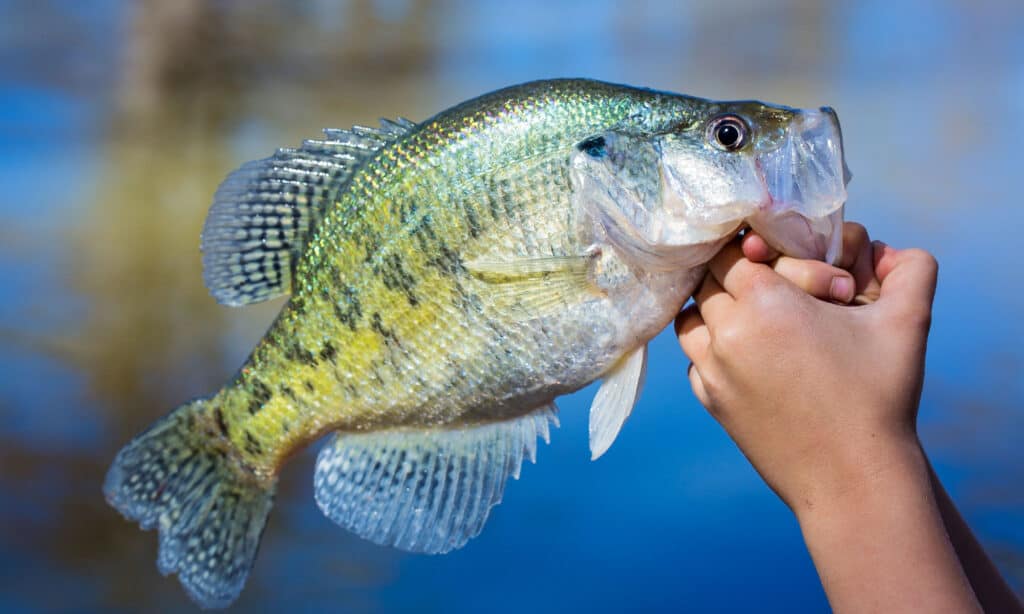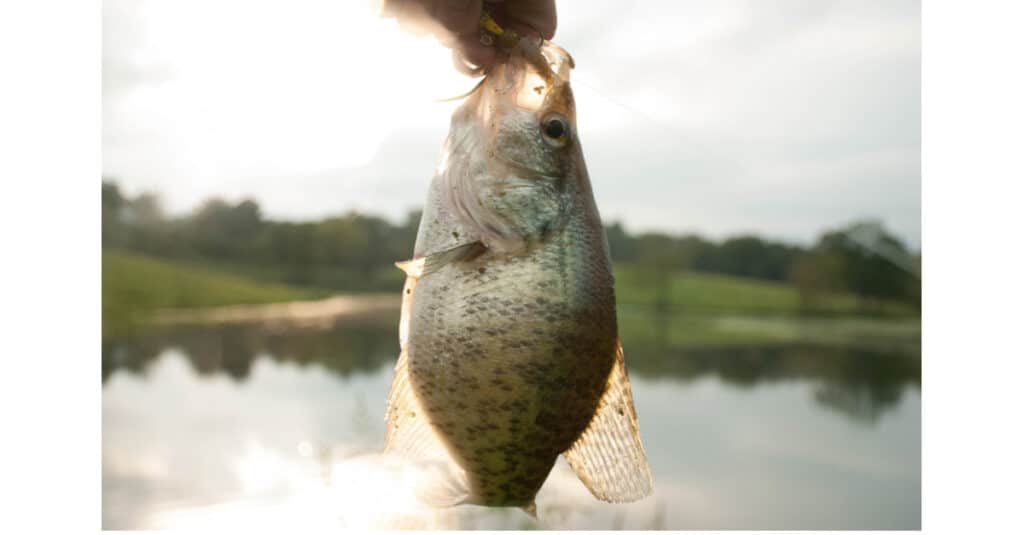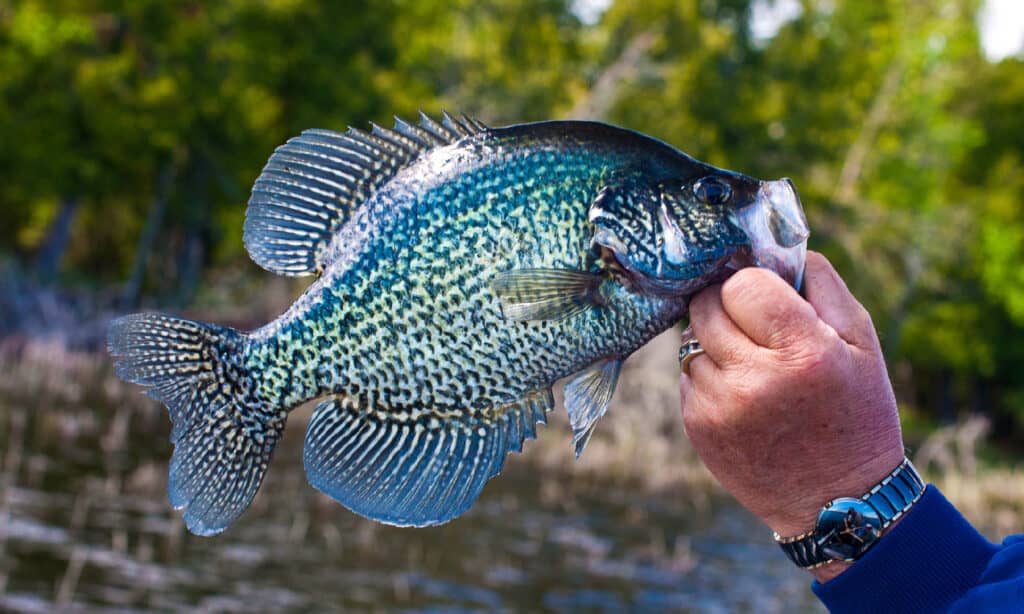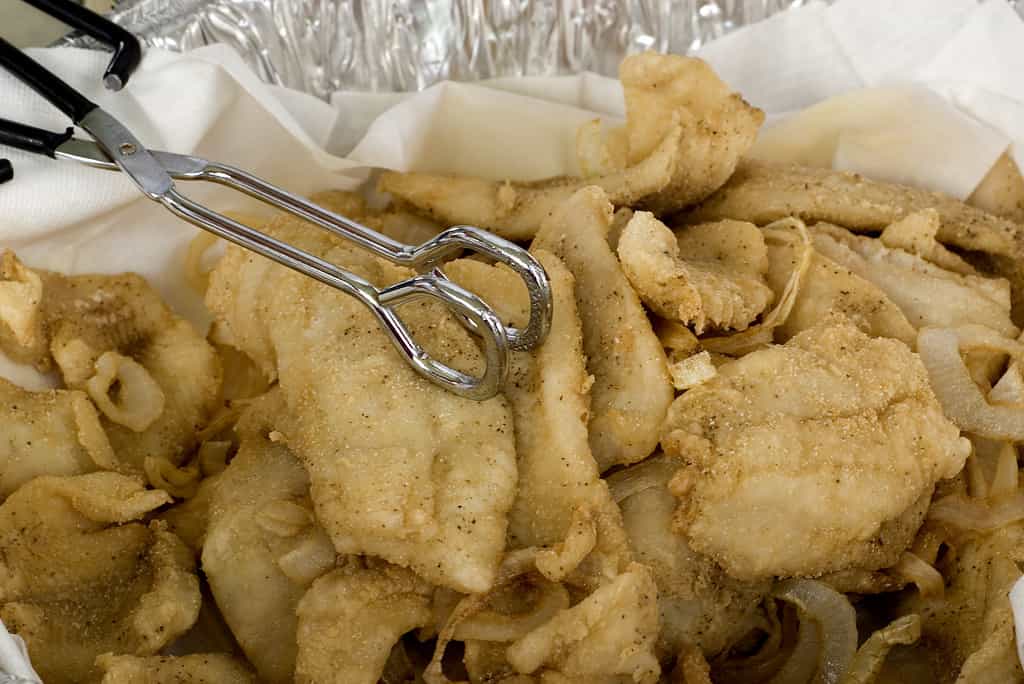A Kansas state fishing record that held strong for almost 60 years has been broken. Bobby Parkhurst of Topeka set a new Kansas record for white crappie when he caught a giant 4.07-pound fish, breaking the previous record of 4.02 pounds set in 1964. The new record white crappie measured 18 inches long with a 14-inch girth. Parkhurst caught this slab in Pottawatomie County while fishing in Pottawatomie State Fishing Lake Number 2.
What Is a Crappie?
The crappie is a panfish, so named because its body is small enough to fit inside a frying pan. It would take quite a frying pan to hold this new Kansas record, though!
An average white crappie weighs from ½ pound to two pounds. Anything over two pounds is quite a catch, but a 4.07-pound white crappie is an absolute monster.

White crappie average from ½ pound to two pounds
©Jennifer White Maxwell/Shutterstock.com
In an interview with local news station KSNT, Parkhurst talked about the moment he hooked into this colossal crappie. He said, “It had some weight to it… I thought it was a walleye at first. And then, when I saw it, I quit reeling and started walking to the bank like a kid… A lot of times when you keep reeling those big ones, they like to come up to the top and smile at you, and then go down without your hook.”
Parkhurst landed the fish on March 5, 2023. It was inspected that same day by John Reinke, Assistant Director of the Kansas Department of Wildlife & Parks (KDWP). Reinke measured and weighed the white crappie using a certified scale. However, Kansas requires a 30-day waiting period to officially certify fishing records.
After the one-month waiting period, the record catch was certified on April 4. KDWP shared the news on social media.
Reinke said, “As fisheries biologists, we get the chance to see a lot of big fish, but this one is certainly for the books. This crappie…truly deserves a spot on the state record list.”
World Record White Crappie
While Parkhurst’s white crappie catch set a new Kansas record, it was not a world record catch. The world record was set in 1957 when Fred Bright landed a behemoth 5.19-pound white crappie in Mississippi.
Crappie Fishing
The crappie is the second most popular gamefish in the United States, trailing only the largemouth bass. Crappies are targeted by both novice and experienced anglers.
Crappies have oversized mouths and predatory attitudes to match. They can be caught on small artificial lures such as soft plastic jigs, spinnerbaits, and hard-body crankbaits. But one of the most popular methods for catching crappie is also one of the simplest: bobber fishing with a live minnow. This method is simple enough for even small children, yet it is highly effective. Countless anglers have filled their boats with crappie while “drowning minnows.” In fact, that is how Parkhurst landed his Kansas record white crappie.
Crappies have several nicknames, one of which is “papermouths.” They received this moniker because their mouths are paper thin, to the point of being translucent. Hard, violent hooksets are better left to catfish or bass fishing. When a crappie bites, a very gentle hookset is all that is needed. Anything more, and the hook may tear through the crappie’s mouth.

Crappies have paper-thin, translucent mouths. Set those hooks gently!
©Brandon Stinnett/Shutterstock.com
Crappie Species
There are two members of the Pomoxis genus. The white crappie (Pomoxis annularis) and the black crappie (Pomoxis nigromaculatus). Crappies are members of the sunfish family (Centrarchidae), along with bluegill, rock bass, and largemouth bass.
The two crappie species are similar in many respects, but their appearance has some notable differences. White crappie is lighter in color than black crappie, hence the names. But, like most fish, colors can vary based on diet, habitat, and other factors. Color alone is sometimes not enough to differentiate the two crappie species, but there are other distinctions.
White crappies have vertical dark lines on their bodies, while black crappies have irregular spots and blotches. Another more subtle difference, white crappies have five or six dorsal spines, while black crappies have seven or eight.

Black crappies have irregular dark blotches.
©iStock.com/SteveOehlenschlager
Black crappies prefer clear water, while white crappie are often found in muddy or stained water habitats. White crappies tend to be a bit smaller than black crappie.
The two closely related fish can hybridize, but their hybrid offspring often struggle to reproduce. Second-generation hybrid crappie is a relative rarity.
Crappies are native to the Mississippi watershed and the Great Lakes, but they were widely distributed throughout the continental United States in the nineteenth and twentieth centuries.
Popular Table Fare
Crappies are among the tastiest freshwater fish in the U.S. Filets from these gamefish are flaky with a subtle sweetness. Many people who typically don’t like the taste of fish enjoy eating crappie because of the light, non-fishy taste.

Crappies are among the tastiest freshwater gamefish in the U.S.
©Cheryl E. Davis/Shutterstock.com
The photo featured at the top of this post is © iStock.com/Jenniveve84
Thank you for reading! Have some feedback for us? Contact the AZ Animals editorial team.






